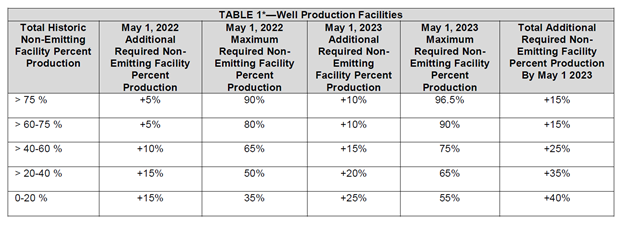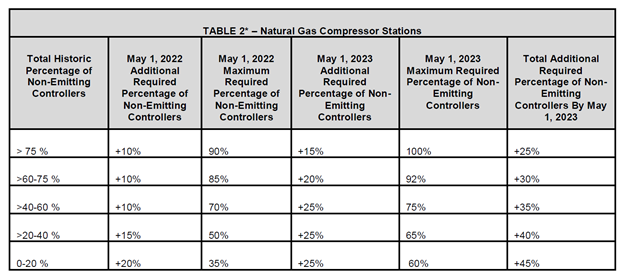Tables 1 and 2 establish the “…minimum additional percentages of non-emitting controllers required by May 1, 2022 and May 1, 2023 based on a company’s historic percentage of non-emitting controllers. Owners and operators need not go beyond the maximum required percentages specified in Table 1 or 2, although they may choose to do so,” (Regulation 7, Part D, Section III.C.4.c. & d.).
For example, if a midstream company’s historic percentage of non-emitting controllers is 40% at their compressor stations, they must retrofit so that an additional 15% of controllers are non-emitting by May 1, 2022 according to Table 2. However, the maximum required percentage of non-emitting controllers for May 1, 2022 is 50%, meaning that the company needs to retrofit only an additional 10% of their controllers to reach compliance.
How to achieve compliance
Compliance can be achieved through either plugging and abandoning a production facility and its wells, permanently removing controllers at compressor stations, or retrofitting the existing controllers at these facilities with non-emitting equivalents. Common non-emitting options include pneumatic controllers driven by compressed air and electric controllers powered by a generator, the electric grid, or solar panels.
Companies must submit their compliance plan containing the required information to the Division on a Division-approved form by September 1, 2021. Operators will also be required to submit an updated compliance plan by July 1 of each year listed in Table 1 and Table 2 unless the company has demonstrated compliance with the “Total Required Non-Emitting Facility Percent Production” the previous year. Do not hesitate to reach out to your Spirit consultant for assistance in producing your Company-Wide Compliance Plan for pneumatic controllers. We are excited and ready to assist your company in attaining compliance.
Am I exempt?
As always, there are some caveats to the rule. For example, natural gas emitting pneumatic controllers that are “necessary for a safety or process purpose that cannot otherwise be met without emitting natural gas,” are not required to retrofit under the rule. Controllers that are located on temporary or portable equipment are also exempt. See Regulation 7, Part D, Section III.C.4.e. for additional details on the applicability of these and other exemptions. Furthermore, an owner or operator that demonstrates that its total statewide oil and natural gas production averages 15 barrels of oil equivalent or less per day per well is not subject to the retrofit requirements (Regulation 7, Part D, Section III.C.4.c.(iv)).
Statewide rulemakings can be confusing and tricky, but they do not have to be! Reach out to one of our air quality professionals and we can answer your questions and help you achieve compliance.
Important deadlines to note:
May 1, 2021: Rule goes into effect.
July 1, 2021: Operators that seek to rely on the exemption in III.C.4.e.(i)(D) to exclude certain emitting pneumatic controllers at qualifying wellheads when determining total historic non-emitting percent production must submit justification to Division by this date. If the Division does not respond by August 15, 2021, justification is deemed approved.
September 1, 2021: Submit initial Company-Wide Compliance Plan to Division.
September 1, 2021: At compressor stations that utilize only non-emitting controllers, must file a one‑time notification to Division that lists each active and operating station and certification that the site utilizes only non-emitting controllers.
October 1, 2021: For well production facilities designated as “Historic Non-Emitting”, must place signage onsite indicating that facility utilizes non-emitting controllers to satisfy requirements of rule.
October 1, 2021: Pneumatic controllers at well production facilities and compressor stations that qualify for exemptions under III.C.4.e.(i)(A-D) must be tagged.
May 1, 2022: First deadline to meet minimum additional required non-emitting percent goal in Table 1 or Table 2.
May 1, 2022: Must tag all pneumatic controllers that emit natural gas to the atmosphere at compressor stations where non-emitting controllers are also located.
May 1, 2022: Must begin required AIMM and AVO inspections for any pneumatic controller claiming the exemption under III.C.4.e.(i)(D) at existing facilities.
July 1, 2022: Operators must submit an updated Company-Wide Compliance Plan unless the operator has demonstrated compliance with the plan the year prior.
May 1, 2023: Second deadline to meet minimum additional required non-emitting percent goal in Table 1 or Table 2.
July 1, 2023: Operators must submit an updated Company-Wide Compliance Plan unless the operator has demonstrated compliance with the plan the year prior.



